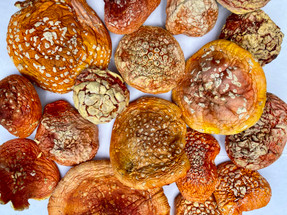Posted by Wild Forest Herbs on Dec 17th 2023
Amanita "Tea"? How to Decarb Amanita Muscaria in Five Simple Steps
Amanita muscaria has two primary psychoactive agents: muscimol and ibotenic acid. In other blogs, we describe muscimol and ibotenic acid in more detail, but in short, decarboxylation of Amanita muscaria is the process of converting ibotenic acid to muscimol. This process is also known as "decarbing" Amanitas, and due to the long boiling process, is often informally referred to as "making tea."
Why do people decarb Amanita muscaria?
The science surrounding ibotenic acid is evolving--and the need to decarb Amanita muscaria is fiercely debated online. In larger doses, ibotenic acid leads to nausea, vomiting, confusion, agitation, and other effects outlined in our blog on ibotenic acid. In small amounts, ibotenic acid is believed to be almost entirely converted to muscimol by the liver, leading many to claim it is safe to eat small amounts, while others insist it’s that decarbing Amanita muscaria is always the safest path.
Do dried Amanita muscaria caps have ibotenic acid?
Yes. Properly drying amanita is believed to convert about 1/3rd of the ibotenic acid into muscimol, but some ibotenic acid will still remain in dried Amanita muscaria caps. Note, any claims that a certain drying technique or temperature will convert all ibotenic acid are simply false – it may be possible to dry amanitas at such a high temperature that all properties of the mushroom are destroyed, but drying amanitas in a way that preserves the muscimol will also preserve some ibotenic acid.
How to decarb Amantia muscaria?
While it’s not possible to ensure 100% decarboxylation without specialized equipment, it is possible to convert most of Amanita muscaria’s ibotenic acid into muscimol following a few simple instructions. This requires:
- Dried Amanita muscaria mushroom caps
- Citric acid or lemon juice
- pH meter (about $10 on Amazon) or pH strips (a bit less accurate but can be bought online or from pet stores as they are used to measure the pH in fish tanks)
- Coffee filter or cheesecloth for straining
Method
Because decarbing Amanita muscaria does take some time, many people prefer to make a larger “batch” which can then be frozen in smaller amounts (e.g., in ice cubes). Larger batches can also be preferable because the potency of each mushroom can vary, so using only one or a few caps can result in a much more uncertain potency than using more caps where the potency will "average out."
- Break the dried mushroom caps into pieces but don’t create a mushroom “powder” as it will be harder to strain.
- Add the mushroom pieces to boiling water. Use enough water that you can boil on low (ideally right around 100 degrees Celsius) with a lid on for about 3 hours without the pot going dry. It’s okay to add more water mid-boil if needed but it’s better to start with enough water so that adding more is not necessary, though you shouldn't lose too much water if you boil on low with the lid on.
- After boiling for 10 minutes, start adding very small amounts of lemon juice or citric acid till the pH is between 2.5 and 3. Once you achieve the right pH, replace the lid and simmer on low. OPTIONAL: after you simmer at the right pH for 30 minutes, the mushrooms can be removed and strained as all of their properties will have transferred to the water. This will create a less gooey final liquid. Alternatively, the mushrooms can be left in.
- Keep the lid on the pot and check the pH every 30-45 minutes or so and add more lemon juice/citric acid if the pH is low or more water if it’s high. If you start to run dry and need to add more water you will also need to add more lemon juice or citric acid. Note: some pH meters won’t read at high temperatures so you can scoop out some liquid and read the pH once it has cooled a little.
- After 3 hours, allow liquid to cool and then strain through a coffee filter or cheese cloth.
Notes
- To determine how potent the liquid is, simply divide the weight of the caps by the volume of liquid, so if you used 1 ounce of caps and have 10 ounces of liquid, every ounce of liquid would contain 0.1 ounces of dried caps.
- One ounce of Amanita muscaria equals just over 28 grams. Most sources consider a microdose to be 0.5-1.0 grams of Amanita Muscaria--for example, the book “Microdosing with Amanita Muscaria” considers 1 gram to be a microdose. It's strongly recommended not to ingest more than this amount.
- The final liquid can be frozen in ice cube trays and transferred to a Ziplock for a longer shelf life--or can be stored in the fridge for about a week.
Although no at-home method will decarb Amanita muscaria 100%, this method will get very close and is also the fastest decarboxylation method available for people who aren’t chemists. Note: the pH of tap and mineral water can vary a lot, so the amount of citric acid or lemon juice will vary for each situation. The measurements of the water and mushrooms don’t matter, what’s important is keeping the pH range as close as possible to the 2.5-3.0 range, as well as the low boil temperature. Wild Forest Herbs has used this method to decarb dried caps to create balms and tinctures (balm recipe to come on a future blog!)
PLEASE NOTE: Wild Forest Herbs believes in sharing the growing scientific understanding of Amanita muscaria. However, our blogs are for educational and scientific study purposes only and nothing in these blogs should be taken as endorsing or recommending eating or ingesting Amanita muscaria. The Federal Food and Drug administration has not approved Amanita muscaria for human consumption.

